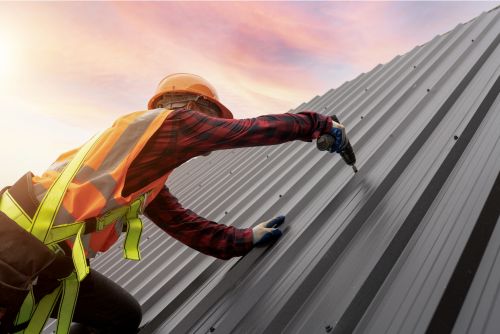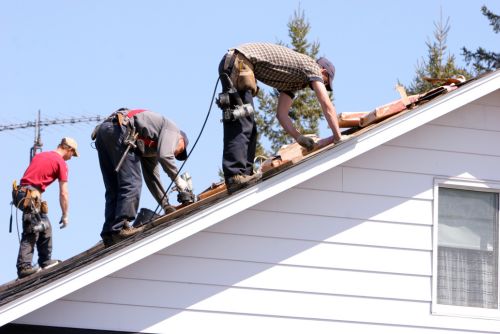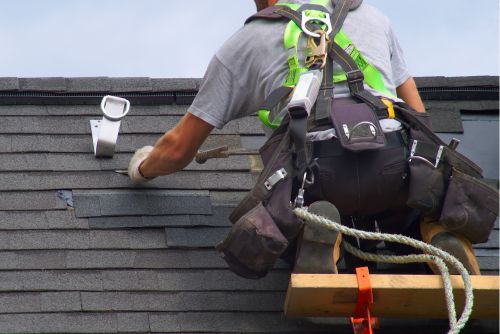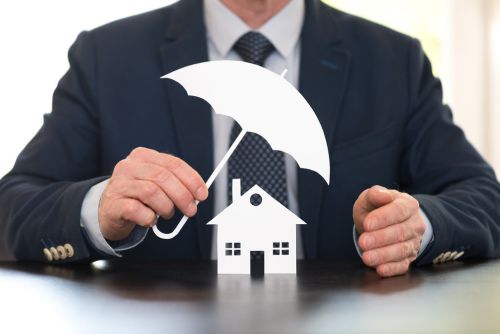When it comes to home improvement projects, there's something exhilarating about taking matters into your own hands. And what better way to satisfy that subconscious desire for innovation than by tackling a project as big as replacing your own roof?
Not only will you save money in the long run, but you'll also experience the satisfaction of accomplishing such a significant task. Imagine the thrill of standing on your newly finished roof, knowing that you were the one who made it all possible.
No longer will you have to rely on expensive contractors or worry about their availability. By doing your own roof, you'll not only save on labor expenses but also gain invaluable knowledge and skills along the way. In this article, we will discover how much will I save if I do my own roof.
Plus, with all the money you'll be saving, think of all the other innovative projects you can tackle around your home! So why wait? Let's dive into this article and explore just how much you can save if you decide to take on the challenge of doing your own roof.
DIY roofs save a lot of money, especially on materials. Materials are a major expense in any roofing project. Professional roofing contractors charge for labor and materials.
By doing it yourself, you can buy roofing materials directly, saving money. The type and quality of roofing materials affect the cost. Even with higher-end options, DIY roofing is cheaper than hiring professionals.
You can choose materials and find the best deals. Many suppliers offer DIYers discounts or promotions, lowering material costs. Another benefit of DIY roofing is that you can buy material based on your needs. As a precaution, professionals order extra supplies, which can be costly.
Measure and plan ahead to avoid overbuying and wasting money on materials. DIY roofing lets you save money on materials without sacrificing quality or style. DIYers may receive discounts and direct supplier access, reducing costs compared to hiring professionals. Labor costs also affect savings.

By doing the roofing myself, I can cut labor costs. Roofing is labor-intensive and often requires professionals, which can be expensive. By tackling the challenge myself, I can save a lot of money.
DIY roof repairs and replacements can save money. Labor is a major expense in roofing projects. You pay contractors and roofers for their time and expertise. Doing the work myself eliminates these costs. That will save me money in the short term, but I can use it elsewhere or buy high-quality roofing materials to make my roof last longer.
Saving on labor doesn't mean sacrificing quality. Anyone can do it with proper research and preparation. Many online resources offer DIY roofers step-by-step instructions and tips. I can repair or replace my roof without paying exorbitant labor costs by following these guides and using my skills.
Besides saving money on labor, doing my own roofing project allows me to grow and innovate. It helps me learn new skills and push my limits. The satisfaction of finishing such a difficult task is immeasurable.
Let's move on to 'tools needed' and learn how to confidently and enthusiastically embark on this exciting journey!
For a successful roofing project, you need the right tools. The right tools can make all the difference when doing your own roof.
The following three tools are essential for a smooth roof installation or repair:
1. Roofing nail gun: This tool is a game-changer when it comes to saving time and effort during a roof project. With a roofing nail gun, you can quickly and securely attach shingles or other roofing materials without having to manually hammer each nail in place. It not only speeds up the process but also ensures that the nails are properly driven into the roof, providing better durability.
2. Roofing shovel: Removing old shingles and debris from your roof is an essential step before installing new ones. A roofing shovel, also known as a tear-off shovel or pitchfork, is specifically designed for this purpose. Its sharp edge allows you to easily lift and remove old shingles without damaging the underlying structure of your roof. This tool will save yourself from potential costly repairs caused by improper removal techniques.
3. Safety harness: Working on a roof can be dangerous, so ensuring your safety should be a top priority. A safety harness is an indispensable tool that can prevent accidents by keeping you securely attached to the roof while working at heights. It provides peace of mind knowing that even if you slip or lose balance, you won't fall off completely.
With these essential tools, you can save time and money on your roof project. However, experience is also needed for success. Let's discuss the required experience without skipping any steps!

This project requires roofing experience. DIY roofing requires significant experience. Roof work requires complex tasks like removing and disposing of old materials, assessing roof damage, and installing new materials. Performing these tasks efficiently can be difficult without experience.
Experience will help you understand roofing project details. You will know how to evaluate your roof, identify areas that need repair or replacement, and choose the right materials. Experience helps you handle tools safely, reducing the risk of accidents or property damage.
Having roofing experience helps you anticipate DIY challenges. Experience helps you plan ahead and solve problems. It prevents mistakes that could cost you time and money in repairs.
DIY roofing requires prior experience. It helps you work on roofs safely and efficiently. Our discussion of how DIY roofing can save you money without sacrificing quality or safety will illuminate its benefits.
DIY roofing can be rewarding because I've completed a difficult task and created a safe and beautiful roof.
Cost savings are a major benefit of DIY roofing. I can avoid professional contractor fees by doing the project myself. I can better manage my budget and use my savings for other important things.
Building my own roof saves money and lets me watch every step. I'll be able to see any damage and fix it. Complex issues like leaks or missing shingles in roofing projects may require immediate attention. I can fix these issues quickly with DIY roofing without waiting for a contractor.
My control over roofing installation material quality is another benefit. Professional contractors may choose cheaper materials to maximize profits. However, by doing it myself, I can choose high-quality materials to make my roof last longer.
Finally, DIY roofing projects teach me specialized skills. This helps me grow personally and gain confidence in future home improvement projects. Doing it myself saves me money on professional services, making me more independent.
These benefits of DIY roofing explain why so many people like it. However, several factors must be considered before starting such a project.

Risks and safety are important when considering a DIY roofing project. Doing your own roof can save money, but you must consider several factors before starting.
First, evaluate your roofing skills. Are you comfortable working at heights? Do you know the roofing materials and methods? You should ask these questions because they can greatly affect your DIY project.
Second, compare the cost of DIY roof repair to that of professional roofing. Saving money is a motivator, but it's important to weigh the risks against the savings. In terms of time saved and costly mistakes, hiring professionals may be cheaper. Consider whether you have all the tools and equipment needed for a successful roofing job. Specialized tools are expensive and can quickly deplete savings.
Consider your roof's size and complexity when deciding to DIY. A confident DIYer with basic skills can handle a small roof. However, larger or more complex roofs may require professional installation to avoid leaks or structural damage.
Consider your skills, costs, and roof size and complexity to decide if DIY roofing is feasible or if hiring professionals is better. Saving money and protecting your home's structure are essential.
Let's move on to another important topic: DIY roofing's time commitment.
Considering DIY roofing? Time commitments may surprise you. DIY roof replacement or repair is difficult and time-consuming.
Before starting this project, know how much time you'll need. Remember that roofing projects require careful planning and preparation. You must research materials, gather tools, and plan a detailed approach. This alone can take a long time if you're new to roofing.
Depending on the size of your roof, such a large project may take days or weeks to complete. Be prepared for long outdoor work hours once installation or repair begins. Roofing is physically demanding and requires precision to be done safely. Depending on your roofing experience, each step may take longer than expected.
Despite the time, many DIY roofers enjoy the satisfaction of finishing their projects. It offers personal growth, new skills, and an innovative approach to home maintenance.
Another consideration is the financial savings of DIY roofing. By working on this project, you can gain experience and cut professional hiring costs.
Consider these savings against the time commitment before choosing a home improvement method that meets your needs and goals.

Some homeowners wonder if how much will I save if I do my own roof. This project requires a lot of time. The potential savings are worth considering.
DIY can save you a lot of money compared to hiring professionals. Your potential savings depend on the cost of hiring professionals versus doing it yourself. Labor costs are a big part of any home improvement project. By cutting out hired help, you'll save money right away. Doing the work yourself lets you control materials and costs. Choose cheaper options without sacrificing quality.
Consider other costs of hiring professionals that won't apply if you do it yourself when calculating your savings. Contractors may charge extra for permits and inspections. These costs can quickly drain your budget. By taking charge, you avoid these extra costs and maximize your savings.
Doing your own roof installation can save you a lot of money compared to hiring professionals. Careful planning and consideration of cost estimates and other expenses can save every penny. Before taking on this project, you must assess the risks.
DIY roof installation has risks that should be considered before starting. Doing it yourself may seem like a good way to save money, but there are risks.
Lack of roofing experience is a major issue. Without training, you may not know the installation techniques and materials needed. It could cause costly mistakes or structural damage to your home.
The physical aspect of DIY roof installation is another risk. Without safety gear, steep, slippery roofs are dangerous to work on. Falls from heights can cause serious injuries or death. Assess your physical abilities to determine if you have the strength and agility for this project.
DIY roofs pose safety and financial risks. You may save money on labor by doing it yourself, but materials and tools cost money. If you make a mistake during installation, costs may rise to repair or replace damaged parts. You must weigh these costs against your desired savings.
Given these risks, DIY roof installation requires proper safety precautions. By wearing harnesses and helmets and following height safety protocols, you can reduce the risk of accidents and injuries.
Professional advice or roof installation workshops can also improve your chances of success.
DIY roof installation has risks that should be considered before starting. Not knowing roofing techniques and materials can cause costly mistakes or structural damage. Falls from heights can cause serious injuries or death when working on roofs. Mistakes during installation may require repairs or replacements, increasing financial risks.
However, taking safety precautions and consulting professionals can reduce these risks and improve your chances of a successful DIY roof installation.

After discussing the risks of DIY roofing, let's discuss safety. Safety should always come first in DIY projects. Working on your roof requires special precautions.
First, get the right safety gear. This includes a sturdy ladder with rubber feet, a harness or safety line for heights, and non-slip shoes for roof traction. Protect yourself from falling debris by wearing gloves, goggles, and a hard hat.
Second, check the weather before working on your roof. Working in extreme heat or bad weather can cause accidents and injuries. For safety, choose a calm day with mild temperatures.
These general safety precautions should be supplemented by specific roof-type safety measures. Scaffolding or temporary platforms can stabilize a steep roof. Working with asphalt shingles requires caution with hot tar and electrical wires.
These safety precautions can greatly reduce roofing accidents and injuries. This will improve craftsmanship and ensure your safety during the project.
Quality work is essential for a long-lasting, professional roof. DIY roof projects require careful craftsmanship. To achieve great results, consider these five factors:
Focusing on these quality workmanship aspects can give you a durable and attractive roof without a roofing contractor. Doing it yourself may save money upfront compared to hiring professionals (average costs range from $5,000 to $12,000 depending on home size), but insurance coverage becomes even more important in case anything goes wrong during or after the project.

Knowing your insurance coverage for a DIY roof project is crucial. Hiring a professional contractor usually includes insurance coverage for job-related damages or accidents, but doing it yourself requires you to get your own. Accidents can happen, and without insurance, you could pay for them.
Your homeowners' insurance may cover your DIY roof project. Some policies may provide coverage for do-it-yourself projects, but check with your provider. Remember that not all policies cover self-performed work, especially if it involves major structural changes like roof replacement.
DIY roof project-specific liability insurance is another option. This insurance can shield you from lawsuits or claims made by people harmed or damaged as a result of your roofing work. This type of insurance may cost extra, so factor it into your budget when calculating the savings of doing the job yourself.
You should also ask your credit card company about insurance benefits. Home improvement credit cards may cover accidental damage or theft. These policies may have restrictions and exclusions.
To avoid financial hardship, you must understand the importance of insurance when doing a DIY roof project. After getting adequate coverage, you must consider permit requirements.
Before starting your DIY roof project, check local permit requirements. Understanding that replacing a roof involves more than just removing old shingles and installing new ones is crucial.
Legal issues include obtaining permits. Check with your local building department or city council to find out what permit requirements apply.
Doing your own roofing and following permit requirements can save you a lot of money. Doing it yourself saves money on professional services. Compliance with regulations shouldn't be sacrificed to save money. In fact, not getting permits can lead to fines or legal trouble.
Consider documentation, fees, and material or installation guidelines when researching roof replacement permit requirements. Some areas restrict roofing materials or architectural styles. By understanding these regulations before starting your project, you can ensure your DIY meets all standards.
Before DIY roof replacement to save money, check local permit requirements. Doing so will keep you legal and save you a lot of money on professional fees.
After discussing permit requirements, let's move on to roof types and their unique considerations without delay!

After learning the permit requirements, I must consider roof type specifics. Each roof type has its own challenges and factors to consider when doing your own roof. Three key roof type considerations:
1. Roofing Material: The type of roofing material you choose will greatly impact both the installation process and the overall durability of your roof. For example, if you have a flat or low-slope roof, you may opt for a built-up roofing system that consists of multiple layers of asphalt and gravel. On the other hand, if you have a pitched roof, you might consider using asphalt shingles or metal roofing panels. Understanding the characteristics and installation requirements of different roofing materials is crucial in ensuring a successful DIY project.
2. Replace vs Repair: Another consideration is whether you need to completely replace your existing roof or if repairs can suffice. If your current roof has significant damage or is nearing the end of its lifespan, it may be more cost-effective in the long run to invest in a full replacement rather than constant repairs. However, if only minor issues exist, such as a few missing shingles or small leaks, repairing those problems could save you time and money.
3. Roofing Costs: Finally, before embarking on a DIY roofing project, it's important to evaluate all potential costs involved. While doing your own roof may seem like an excellent way to save money initially, there are expenses beyond just material costs to consider. You'll need specialized tools and equipment for safe installation, proper safety gear such as harnesses and helmets, and potentially even professional assistance for certain tasks like removing old roofing materials or handling complex installations. Factoring in these additional costs will give you a more accurate estimate of how much money you could potentially save by doing your own roof.
Consider these factors to determine if doing it yourself is feasible and cost-effective.
Maintaining my DIY roof is essential for its longevity and functionality. As a homeowner, I know my roof needs regular maintenance. I can avoid expensive repairs by inspecting and maintaining my roof.
Cleanliness and debris removal are roof maintenance tasks. Roof and gutter clogs from leaves, branches, and other debris can cause water damage. This debris should be removed regularly to avoid leaks and structural damage. Doing this myself saves money and gives me the satisfaction of actively maintaining my home.
DIY roof maintenance requires regular inspections. This lets me spot wear and damage early before they worsen. Early detection lets me fix issues quickly and avoid costly repairs. Knowing I'm protecting my investment by inspecting my roof gives me peace of mind.
In addition to regular maintenance, doing my own roof lets me fix minor issues. Fixing loose shingles or damaged flashing with basic tools and materials is often easy. Learning how to fix small roof repairs myself saves money and empowers me as a homeowner.
By maintaining and repairing my DIY roof, I can save money and keep it working. Responsible homeowners who want to save money and enjoy a well-maintained roof must clean, inspect, and repair. Why not lead and do it?
Finally, DIY roofing can save a lot. We have discovered how much will I save if I do my own roof in this article. Doing it yourself can save thousands of dollars on labor. The cost of roofing materials and tools must be considered.
DIY roofing may seem daunting, but with the right experience and knowledge, it can be rewarding and cost-effective. By building your own roof, you can control quality and ensure proper maintenance and repairs.
Benefits must be weighed against risks like insurance and permit requirements. Location and roof type may affect regulations. Before starting a DIY roofing project, consult professionals or local authorities.
If you're confident in your abilities and willing to put in the time and effort, installing or repairing a roof yourself can save you a lot. Be sure to research materials, safety, and legal requirements. Maintaining a sturdy roof is crucial for long-term home protection.
Sure, you can definitely DIY your roof even if you have no prior experience in roofing. It may seem daunting at first, but with the right research, tools, and a little bit of determination, you can successfully tackle this project.
Not only will you save money by doing it yourself, but you'll also gain a sense of accomplishment and learn new skills along the way. Imagine the satisfaction of knowing that you took matters into your own hands and transformed your roof into something amazing.
So go ahead, embrace the spirit of innovation and give it a try – you might just surprise yourself with what you can achieve!
You should be aware of several DIY roofing risks. First and foremost, roofing novices are more likely to make mistakes that could cost you or cause an accident.
Working on a roof can be physically demanding and dangerous if you don't have the right safety gear or knowledge of rooftop navigation.
Furthermore, without professional training, it may be difficult to accurately assess your roof's condition and identify underlying issues that could worsen over time.
Finally, DIY roof repairs may void home warranties and insurance. You must consider these risks before deciding to do your own roofing.
When working on my roof, safety is paramount. This DIY project requires protective gear like sturdy shoes with good traction and a hard hat. I also need a stable ladder and fall protection gear like harnesses and safety nets.
Working on the roof requires awareness of unstable surfaces and electrical wires. By taking precautions, I protect myself from accidents and create an innovative environment where I can confidently finish the job.
The size of your roof, your experience, and the complexity of the job can all affect how long a DIY roofing project takes.
However, doing this project yourself saves money, gives you a sense of accomplishment, and encourages creativity. By being creative and challenging yourself, you can improve your skills and make your roof unique.
While the time frame may vary, DIY roofing projects can be rewarding and creative for those who take on the challenge.
I must know if I need permits to work on my roof. Check local authorities and building codes to ensure compliance. Permits ensure safe work and protect me from legal issues.
These steps give me confidence to start my DIY roofing project, knowing I'm following regulations and prioritizing safety.